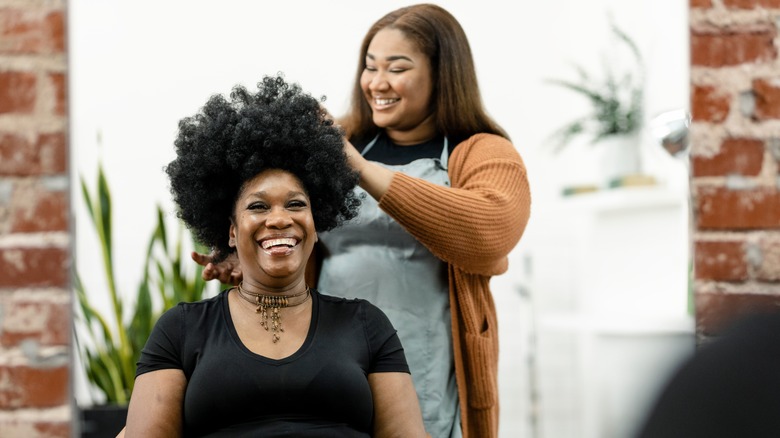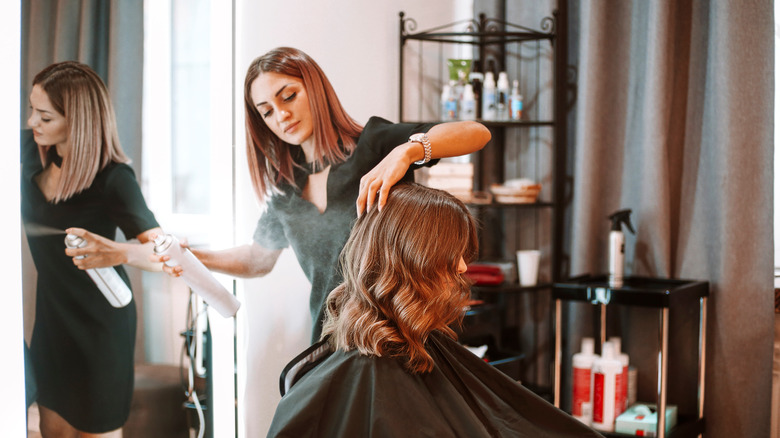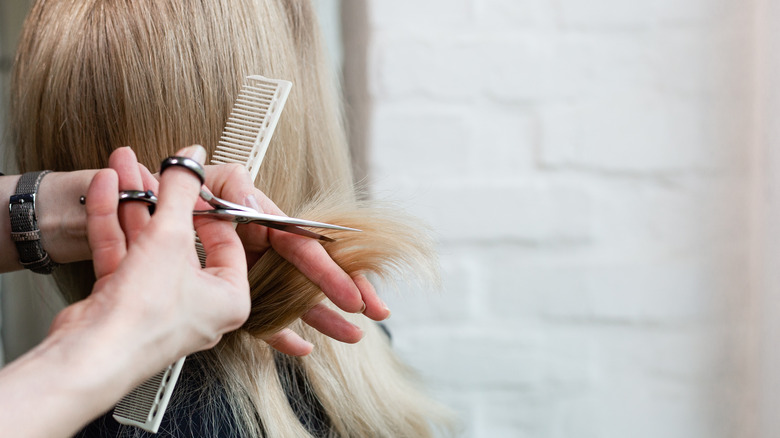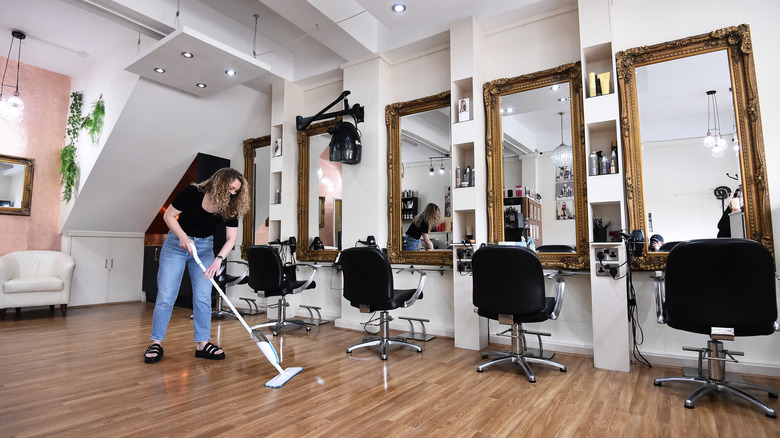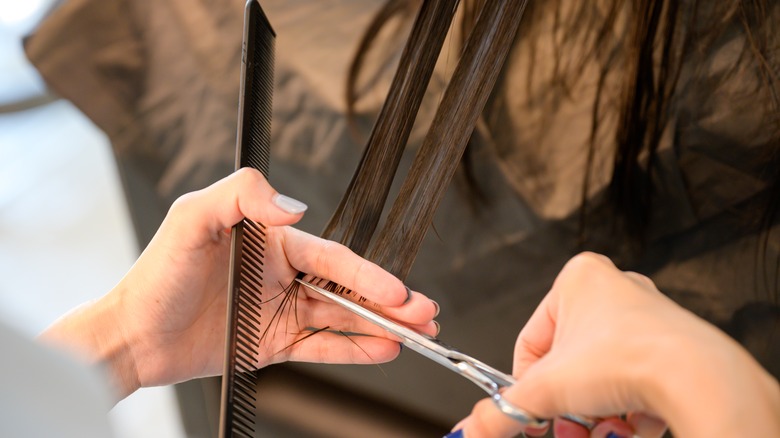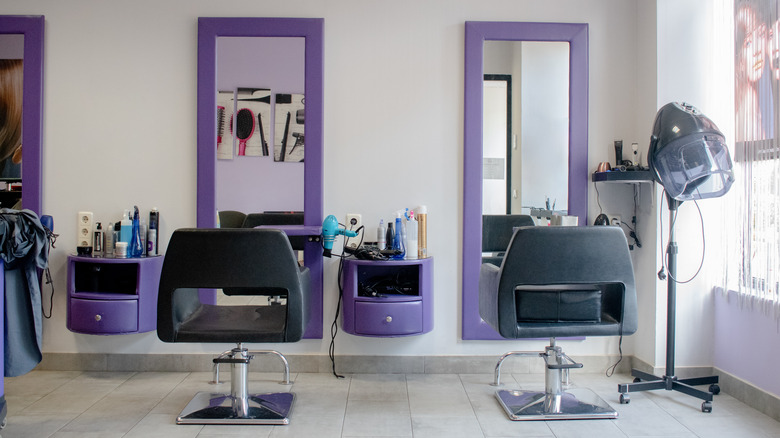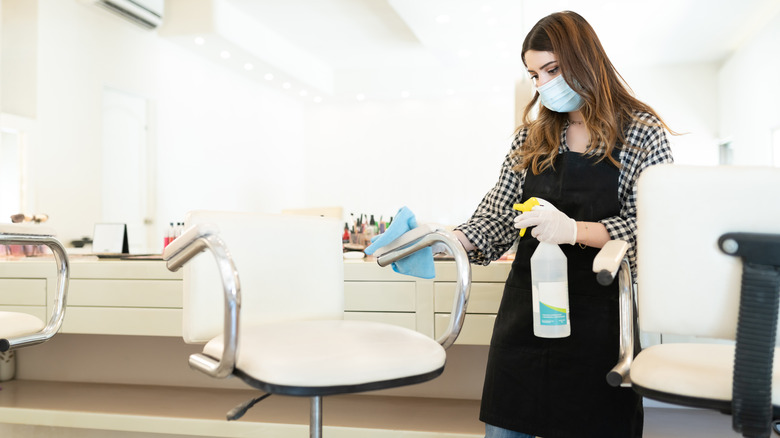Here's Why Quality Haircuts Are Always So Expensive
Upon exiting the salon chair after receiving a fresh new haircut, there's arguably no better feeling in the world than glancing in the mirror to give your silky and soft new locks a little flip as you embrace a whole new level of confidence. You're ready to take on the world, ask out that cute somebody you've had your eye on for months, and flood social media with some long overdue updated selfies. After walking up to the register to pay, while undeniably unable to keep your hands away from the softness of your new mane, the front desk associate tells you your total. Wait — she said how much?
As amazing as that post-salon feeling is, we often find ourselves asking just how worth the haircut was for the price. Reluctantly handing the cashier our cards, we wonder if we may have been better off having a friend or family member cut it. How hard can it be, right?
In the United States, salon haircuts for women can stack up to almost $100 — and that's just an average. Prices can certainly be even more than that, depending on numerous factors. However, believe it or not, there's actually way more that goes into a simple haircut than someone just snipping away with a pair of scissors. Many of us don't realize how much time, money, and years have gone into what makes a good haircut, well, a good haircut.
Stylist experience level
Contrary to popular belief, all haircuts are not created equal. Sure, every stylist has to go through beauty school and learn the same things as every other stylist, but the main purpose of beauty school is simply to teach students how to pass the state board exam for licensure. Most cosmetology schools don't delve into advanced techniques and trends, and because the typical full-time cosmetology school length is only eight months to a few years, students aren't going to come out as experienced stylists — this is something that comes only with years of practice.
Moreover, a good, even haircut will actually last longer, grow out better, and require less maintenance to look good. Not to say that newer stylists are "bad" by any means, but your chances of landing an expert haircut are, naturally, going to be in the hands of someone with experience. How to ensure your scheduling with someone who's put in the years of hard work?
Most salons operate on a level system, meaning that they are ranked by experience. Typically, you will see junior, senior, and master stylists. Each level will have a different range of prices, and the higher they go up, the higher quality you'll be getting. So, the next time you're thinking about cutting your own hair or having Mom or Aunt Susan take a pair of scissors to your locks, be sure to consider the overall integrity of your hair first.
Continued learning and license renewal
Learning how to master the world of hair isn't a one-and-done deal after receiving your cosmetology license. Beauty is an art form that is constantly evolving, moving with the trends and times, and on the receiving end of new and innovative techniques and technologies. In order to keep stylists on their toes, many salons pay for them to receive some form of yearly — or even monthly — continued learning classes, workshops, or seminars.
How does this translate in the real world? Let's say the stylist you choose to go to has been doing hair for 40 years, but has the most incredible and cheap prices. Because the prices are so low, her salon can't afford to send her to any continued learning courses. Can she totally nail a basic layered cut that was hot in 1994? Of course. Can she replicate that picture you brought in of Gigi Hadid rocking a cute, modern bob on the runway last week? Probably not.
So, basically, even though a stylist may have years and years of experience, it won't necessarily be what you're looking for in terms of style. These are all things to consider when it comes to price. On top of this, stylists are required to renew their state license every few years, and those fees can add up over time. With some states charging almost $100 every two years, these costs have to come out of a stylist's own pocket.
Haircut level of difficulty
In the old days, a man could walk out of a salon paying only $20 for an elaborate cut, while a woman could walk out paying close to $60 for a basic trim. But as times are changing, more and more salons are throwing gender-based haircuts out the window and openly embracing hourly rates.
"It has never made any sense to me that femmes and women have to pay more than men ― sometimes more than double," Dani Bee, stylist and co-owner of Bee Sweet in Denver, Colorado, told HuffPost. Bee's salon has one flat rate of $45 per haircut, which goes up depending on the time it takes to complete a cut."Perhaps most critically," she continued, "I'm specifically focused on providing a hair space that's a safe and celebratory space for the queer community, and that includes a lot of trans and nonbinary clients. Haircuts are priced-based on the value of my time."
If $45 seems like a lot for a base price, consider that most stylists operate on commission. A big majority of that price is going towards the functioning of the salon, while a stylist will see only a fraction of that cost. Plus, if the cut you request is more complex than most, requiring more of the stylist's time, you should expect to pay more for the service.
Schooling and licensure
There are plenty of misconceptions about beauty school — one of them being that because it's not college, it's cheap and easy. While it's certainly not easy, it's especially not cheap. Like most schools, the cost of beauty school will differ depending on location and reputation.
Beauty schools located in major cities can cost all the way up to $20,000 for nine months of courses, which is only slightly less than the national average of college tuition per year. If you'd pay more for a lawyer who went to a prestigious school, why wouldn't you do the same for your hairstylist — someone who has a significant impact on the way you look?
Not only do stylists have to pay to complete their education, but they also must pay to receive their licenses. Some states, such as Vermont, charge upwards of $375 for a state license that is to be paid out of pocket by the student.
Time and consultation
Even during your first trip to the hair salon as a child, you can probably recall the hairdresser conducting a consultation with your parent or guardian. And now, even if you've been seeing the same stylist for years, they are probably still going to do a consultation at the beginning of the appointment.
What are you looking for out of this appointment? What are some of your overall hair goals? What products do you use at home? All of these are questions that you likely get asked with a haircut, and it's not so a stylist can waste time or because they feel like chatting. These moments during the consultation are crucial and can be one of the big differences between a cheap and expensive haircut.
Most people know that time is money, and this is especially true in a hair salon. By taking these extra few minutes to learn about you, your hair goals, and what you're expecting, your stylist is sacrificing money they could be making on other services just to ensure that they will be doing your haircut correctly and accurately — the way you want it done. To make up for this lost time, many salons will factor in the cost of a consultation into the overall price of the cut.
Workspace cost
Like any other business, a salon is a reflection of the people who created it — and just like you, these creators are people with dreams, goals, and plans. They had a vision at one point to open a salon that would represent who they are and what they want to bring to the community and world. While these individuals themselves are the most important part of making a business thrive, the overall client experience is the second driving factor in a successful salon. This means that any decor, refreshments for guests, waiting room magazine subscriptions and chairs, and even the building itself are all an expense.
On top of this, most salons must pay for electricity and water, internet and phone, taxes, and advertisements. For stylists who rent a booth in an established salon, they will oftentimes be charged extra in rent for these amenities, so even if you're seeing an independent stylist who doesn't belong to a specific salon, they still have plenty of fees to pay. In order to cover these costs and still make a profit, your stylist will calculate exactly how much each service should cost. The result is how much you can expect to pay for a haircut.
Location
In all locations, the cost of living and the cost of services generally balance out. For example, the minimum wage in New York is $15 an hour; however, the average haircut in the state costs around $73. On the flip side, Idaho has a minimum wage of $7.25 an hour, but an average haircut in a rural town in the state probably will cost nowhere near as much as New York's prices. This is because a salon in New York will generally be way more expensive to operate and maintain than one in a town or city where the cost of living is lower.
Not only does the cost of living pay a part, but the talent level of stylists is going to vary by city. There are talented hair designers anywhere you go, but generally, most hairdressers know that there is going to be more opportunity and more clientele in bigger cities. These big-city hair salons are aware of this, so they tend to make the hiring process a bit more extensive than perhaps a rural salon looking to hire; thus, you are paying for talent in big cities as well.
Quality tools
When a painter creates a painting, it takes a natural level of creativity and talent to make their work beautiful, no matter how much their brushes and paint cost them. However, small details like a finely crafted archival canvas or an expertly formulated varnish are going to take the painting a few steps even further. Quality tools will be that extra mile in the overall experience of viewing a painting, and the same principle applies to hair. Although a good haircut can be done with inexpensive materials, better tools will make it great.
Which scissors are stylists loving right now? "Hikari Phoenix Cosmos and Hikari Cosmo Dragon," Beverly Hills hair stylist Buddy Porter tells Mane Addicts. "I dry cut mostly everything, and both of these scissors are crafted to effortlessly cut wet and dry hair. The dragons have a concave outside blade edge fits perfectly against your fingers when performing palm-to-palm cutting. This results in ultimate precision as the hair is always cut at a perfect 90-degree angle."
So, how much does a pair of Hikari scissors cost? A more inexpensive pair can run anywhere around $350, but the top-notch models go as high as $2,000.
Quality supplies
Supplies might seem like they go hand-in-hand with tools, but it turns out that salon supplies are an entire category of their own. Think of a stylist's tools as a one-time purchase every two to seven years — things like combs, hairdryers, scissors, razors, curling irons, etc., can all be considered tools. Supplies, on the other hand, are items that need to be continuously replenished.
Things like gloves, new towels, washing detergent for linens, shampoo, conditioner, styling products, and capes are all salon requirements that need replacing and filling often. It might sound like these are purchases that can be kept at a minimum price, but if a salon is quite busy with hundreds of clients coming in and out each week, these costs do add up.
In fact, according to Goldie, a hair salon should expect to pay anywhere between $700 to $2,000 in "monthly fees." Certified Sisterlocks Consultant Keonah McCullough shared with the website just how difficult operating a salon is, stating that the recurring fees make things "deceptively difficult." She continued by explaining that even though the initial startup cost is a lot, salon owners soon realize just how often they need more supplies.
Cleaning protocols
Salon cleaning protocols vary by state, but they are generally fairly strict since salons work on so many people all day. One general law is that stylists are required to disinfect and clean their tools, as well as switch out dirty towels for clean ones, after every single client.
Moreover, combs and brushes must be submerged in disinfectant, sinks and chairs must be sanitized at the end of the night, and laundry must be kept up with to ensure plenty of fresh towels are on hand. Cleaning supplies like alcohol, disinfectants, floor and counter cleaners, and even bathroom cleaning products need to be kept on hand, which all add up to monthly fees.
Additionally, every salon must be equipped with a first aid kit and a ventilating system for chemicals. While these are general laws, many individual salons have their own cleaning practices as well as state-mandatory procedures.
Required insurances
In 2021, Robin Gunby visited her local hair salon in Fort Worth, Texas. Gunby's hair was reportedly healthy before her visit, and all seemed well during her appointment until she started feeling a burning sensation on her scalp. According to Law.com, when she returned home, "clumps of her hair began falling out" as she realized that the product had been incorrectly applied. In the end, Gunby ended up suing the salon and ultimately settling a $180,000 case in her favor. Similarly, in 2014 another woman won $10.2 million after suing a salon for misusing a popular shampoo brand.
Stories like these are precisely why salons spend so much money on monthly insurance. As people working with chemicals and products all day, stylists are bound to run into situations where a certain chemical, styling cream, or conditioner either just doesn't sit well with a client or there was an accidental misuse of these potentially dangerous supplies. Furthermore, most salon leases require at least general liability insurance, which will protect a salon from client injuries, client property damage, and advertising injuries. Salons can also purchase professional liability insurance to cover them from lawsuits such as the Gunby incident, which is paid monthly or annually.
Tipping your stylist
Many stylists rely on tips to make a dependable living. If a salon pays their employees commission, then remember that your stylist is only seeing a small percentage of your total bill. If a salon pays an hourly rate, these set figures typically aren't enough to cover the hard work and labor your stylist has put in to make you look good. As a general guide when tipping for beauty services, around 20% of your total is typically recommended, and this can be split up amongst anyone who may have helped your stylist, such as a shampoo assistant.
But what if your haircut is really, really bad? According to Consumer Reports, you should "never skip a tip." Instead, aim for a lower amount, and don't be afraid to be politely vocal about not being in love with your hair. In most cases, a stylist will always offer to fix it or ask another stylist for help to fix it. In an instance where a stylist was rude to you, simply ask to speak to a manager; however, in most cases, always plan on adding in a tip.
